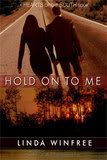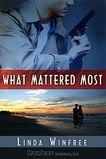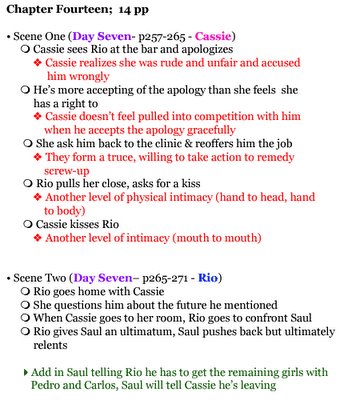Tool time - Versatile Outline

If you've ever tried to make significant revisions to a 400+ page manuscript numerous times (like 30 or so), somewhere along the way you realize how limited your brain power is. What happened in that chapter? That scene? Am I repeating this here? Did I follow that thread through there? What day am I on? What was the weather like? Who's pov am I in?
And on and on and on...
If you're writing deep plot with various twists, if you've created complex characters with various internal and external conflict...you need a tool to keep track of all this information as you go back and integrate changes.
Additionally, if you're writing romantic suspense, you need to keep track of both the plot line (increasing tension) and the romance line (increasing attraction/sexual tension).
There are numerous methods of tracking your story. I've tried scene cards, storyboarding, and too many charts to mention, but nothing worked for me on the complex level I needed.
I think I've finally created a functional model--at least one that fits me and my style of writing. It amounts to a watered down version of several techniques and sprinkled with my own ideas to fit my specific needs.
One of the best features of this method is its adaptablity to your needs, your writing style--track what you want to track according to your unique novel, your strengths and weaknesses as a writer. If your manuscript utilizes weather as an antagonist, you can track weather changes. If you have a hard time keeping your timeline straight (one of my major challenges), this will clear it up for you at a glance.
It can be as simplistic or complex as you choose to make it. It can also be used as a pre-plotting outline to give yourself direction.
Here's my tool: (I've posted a Word version of this on my site which you can download/edit/utilize/etc.)
Explanations
Chapter #: Obvious
#pp: Number of pages in chapter. Beneficial to see what chapters are long, which are short, and how you might move things around to alter that without having to page through your ms over and over.
Scene #: Obvious
Day #: Great information to make sure your timeline is in order. Color and bold font for information at a glance.
P#-#:Pages included in that scene.
See length of scenes, use to locate page numbers to administer changes.
POV Character : Track frequency of pov between characters. Essential when trying to split your ms equally between hero and heroine or sprinkling in villains and secondary characters. Color change according to character ID. Bold font for information at a glance.
Plot point: The main plot element that occurs in this scene
Romance Element: Tracking the romance development through the novel
This could also be utilized to track tension development and/or mystery development, etc.
Revision: Elements that exist in your ms that need to be changes during revision. (If you change plot point 3 in chapter 2, you'll have to change several other plot points deeper into the novel.)
Some other items you may want to include in your outline might include:
- Time of day
- Setting (weather/clothing/etc.)
- Weather
- Plot twist
- Foreshadowing elements
Some other items you could track with this technique could be:
- Tracking character emotions/development
- Tracking character arc
- Tracking tension escalation
With this format I can get a quick visual idea of novel structure: chapters, chapter length, number of scenes per chapter, character presence, placement of romantic elements. I can also follow the plot points to eliminate holes and assure a smooth escalation of events.
Here's a two chapter example from my ms Safe In Enemy Arms:
Note: I've used the outline to include Linda Howard's 12 points of intimacy here to aid the tracking of romantic development (i.e., eyes to body)
Note: I've shown both romantic development and character arc development in the romantic element here. You could separate those out if you want more detail.
That's it!
Hope this helps some of you through that twisted test of revising.








4Comments:
This is waay too much thinking for me!
I did something similar to this on a spreadsheet (with the help of my friend Lisa who's anal about stuff like this). Me - the nonplotter! I actually like it because I can do one or two chapters ahead, and it lets me see POV easily (colors), page lengths, total word count, etc. I'll email it to you so you can see a different take on the same sort of thing.
Yes, I definitely think too much. :-)
I liked this example. I use outlining extensively, but I do a different sort of format. (Lawyer in me can't banish law school outlining techinques so that's what I return to time and again) but I got lots of good ideas from this.
Post a Comment
<< Home